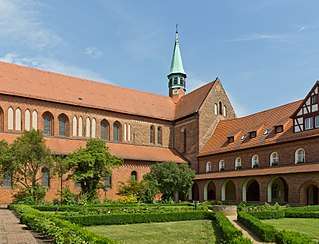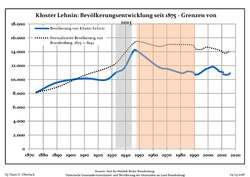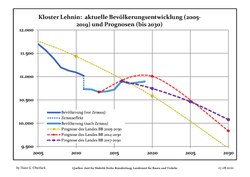Kloster Lehnin
Kloster Lehnin, or just Lehnin, is a municipality in the German state of Brandenburg. It lies about 24 km (15 mi) west-south-west of Potsdam.
Kloster Lehnin | |
|---|---|
 | |
 Coat of arms | |
Location of Kloster Lehnin within Potsdam-Mittelmark district  | |
 Kloster Lehnin  Kloster Lehnin | |
| Coordinates: 52°19′00″N 12°45′00″E | |
| Country | Germany |
| State | Brandenburg |
| District | Potsdam-Mittelmark |
| Subdivisions | 14 Ortsteile |
| Government | |
| • Mayor | Uwe Brückner |
| Area | |
| • Total | 199.30 km2 (76.95 sq mi) |
| Elevation | 36 m (118 ft) |
| Population (2018-12-31)[1] | |
| • Total | 10,871 |
| • Density | 55/km2 (140/sq mi) |
| Time zone | CET/CEST (UTC+1/+2) |
| Postal codes | 14542, 14778, 14797 |
| Dialling codes | 03382, 033207 |
| Vehicle registration | PM |
| Website | www.lehnin.de |
Overview
Kloster Lehnin was established on 1 April 2002 by the merger of 14 villages:
|
|
|
The centre of the municipality is Lehnin. It is best known for Lehnin Abbey, the oldest monastery in the Margraviate of Brandenburg, established in 1180 by Margrave Otto I. The adjacent settlement developed about 1415 out of a market held by the monks outside the abbey walls.
Today, this well-maintained area includes the renovated monastery church and other Gothic buildings.
In addition to tourism, Kloster Lehnin's local economy is supported primarily by
- the Evangelical Deaconess House Berlin Teltow Lehnin, a hospital network
- Hansa-Heemann AG, a mineral water and soft drinks company
- Grand River Enterprise, a cigarette company
- Windeck, a metal construction company.
All of these companies are established in the industrial area, Rietz.[2]
Demography
 Development of population since 1875 within the current Boundaries (Blue Line: Population; Dotted Line: Comparison to Population development in Brandenburg state; Grey Background: Time of Nazi Germany; Red Background: Time of communist East Germany)
Development of population since 1875 within the current Boundaries (Blue Line: Population; Dotted Line: Comparison to Population development in Brandenburg state; Grey Background: Time of Nazi Germany; Red Background: Time of communist East Germany) Recent Population Development and Projections (Population Development before Census 2011 (blue line); Recent Population Development according to the Census in Germany in 2011 (blue bordered line); Official projections for 2005-2030 (yellow line); for 2014-2030 (red line); for 2017-2030 (scarlet line)
Recent Population Development and Projections (Population Development before Census 2011 (blue line); Recent Population Development according to the Census in Germany in 2011 (blue bordered line); Official projections for 2005-2030 (yellow line); for 2014-2030 (red line); for 2017-2030 (scarlet line)
|
|
|
Notable people
- Roland Kaiser (1943–1998), actor
- Waltraud Kretzschmar (1948–2018), handball player
- Wolfgang Schmidt (*1966), serial killer
Photogallery
 Church in Göhlsdorf
Church in Göhlsdorf Church in Krahne
Church in Krahne Manor house and fire station in Krahne
Manor house and fire station in Krahne Church in Rädel
Church in Rädel Manor house in Reckahn
Manor house in Reckahn Church in Reckahn-Meßdunk
Church in Reckahn-Meßdunk Listed hotel building in Lehnin
Listed hotel building in Lehnin
gollark: I don't want to delve into cryptic undocumented realms of configuration to apply tweaks which will randomly break later.
gollark: On Arch the only "set dates" are stuff like "you need to update pacman within a year or so before we break backward compatibility".
gollark: Well, enjoy randomly being interrupted!
gollark: It's like being angry if they came up to me and forced it down my throat if I didn't eat it within 10 seconds.
gollark: Forced updates: have seen.Candy Crush randomly appearing: have seen.Advertising: have seen screenshots.
See also
References
- "Bevölkerung im Land Brandenburg nach amtsfreien Gemeinden, Ämtern und Gemeinden 31. Dezember 2018". Amt für Statistik Berlin-Brandenburg (in German). July 2019.
- https://translate.google.com/translate?hl=en&sl=de&u=http://www.klosterlehnin.de/&prev=/search%3Fq%3Dkloster%2Blehnin%26espv%3D210%26es_sm%3D91%26biw%3D1920%26bih%3D1102
- Detailed data sources are to be found in the Wikimedia Commons.Population Projection Brandenburg at Wikimedia Commons
| Wikimedia Commons has media related to Kloster Lehnin (municipality). |
This article is issued from Wikipedia. The text is licensed under Creative Commons - Attribution - Sharealike. Additional terms may apply for the media files.